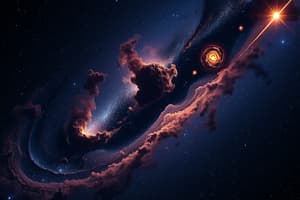Podcast
Questions and Answers
What is the general orbital shape of comets?
What is the general orbital shape of comets?
- Parabolic
- Highly elliptical (correct)
- Circular
- Linear
What is the primary constituent of a comet's nucleus?
What is the primary constituent of a comet's nucleus?
- Gas and dust
- Ice and dust (correct)
- Metallic substances
- Rocky materials
What happens to a comet as it approaches the sun?
What happens to a comet as it approaches the sun?
- It loses its tail
- It develops a tail of gas and dust (correct)
- It becomes a planet
- It increases in volume
What types of materials are found in a comet's chemical composition?
What types of materials are found in a comet's chemical composition?
From which regions do comets primarily originate?
From which regions do comets primarily originate?
What is the significance of comets in terms of scientific research?
What is the significance of comets in terms of scientific research?
Which component of a comet typically points away from the sun?
Which component of a comet typically points away from the sun?
What is the typical orbital period range for comets?
What is the typical orbital period range for comets?
What is the primary origin of most meteoroids?
What is the primary origin of most meteoroids?
What defines a meteor?
What defines a meteor?
Which chemical compositions are typically found in meteoroids?
Which chemical compositions are typically found in meteoroids?
Which characteristic does not apply to meteoroids?
Which characteristic does not apply to meteoroids?
What is the result when a meteoroid survives impact with the Earth?
What is the result when a meteoroid survives impact with the Earth?
What type of meteorite is stony in nature and consists mainly of silicates?
What type of meteorite is stony in nature and consists mainly of silicates?
What term describes the visible glow of a meteor as it enters the Earth's atmosphere?
What term describes the visible glow of a meteor as it enters the Earth's atmosphere?
Which of the following is NOT a characteristic of a meteorite?
Which of the following is NOT a characteristic of a meteorite?
What is the function of the nucleus in a comet?
What is the function of the nucleus in a comet?
How is the gas tail of a comet oriented in relation to the Sun?
How is the gas tail of a comet oriented in relation to the Sun?
What describes the coma of a comet?
What describes the coma of a comet?
Which characteristic primarily distinguishes the gas tail from the dust tail of a comet?
Which characteristic primarily distinguishes the gas tail from the dust tail of a comet?
In terms of orbital characteristics, what is a common feature of comets?
In terms of orbital characteristics, what is a common feature of comets?
What role does the solar wind play in the formation of a comet's gas tail?
What role does the solar wind play in the formation of a comet's gas tail?
What components are primarily found in the nucleus of a comet?
What components are primarily found in the nucleus of a comet?
Which of the following statements about the dust tail is correct?
Which of the following statements about the dust tail is correct?
Flashcards
Comet
Comet
A celestial object made of ice, dust, and gases that forms a tail when near the sun.
Comet Origin
Comet Origin
Comets originate from the Kuiper Belt and Oort Cloud.
Comet Shape
Comet Shape
Comets have irregular or varied shapes.
Comet Composition
Comet Composition
Signup and view all the flashcards
Comet Orbit
Comet Orbit
Signup and view all the flashcards
Comet Orbital Period
Comet Orbital Period
Signup and view all the flashcards
Comet Importance
Comet Importance
Signup and view all the flashcards
Comet Parts (coma)
Comet Parts (coma)
Signup and view all the flashcards
Comet Parts
Comet Parts
Signup and view all the flashcards
Comet Nucleus
Comet Nucleus
Signup and view all the flashcards
Comet Coma
Comet Coma
Signup and view all the flashcards
Gas Tail
Gas Tail
Signup and view all the flashcards
Dust Tail
Dust Tail
Signup and view all the flashcards
Solar Wind
Solar Wind
Signup and view all the flashcards
Comet Tail Direction
Comet Tail Direction
Signup and view all the flashcards
Meteoroid
Meteoroid
Signup and view all the flashcards
Meteor
Meteor
Signup and view all the flashcards
Meteorite
Meteorite
Signup and view all the flashcards
Origin of Meteoroids
Origin of Meteoroids
Signup and view all the flashcards
Composition of Meteorites
Composition of Meteorites
Signup and view all the flashcards
Meteor Impact Evidence
Meteor Impact Evidence
Signup and view all the flashcards
Meteor Brightness
Meteor Brightness
Signup and view all the flashcards
Meteoroid in Space
Meteoroid in Space
Signup and view all the flashcards
Study Notes
Introduction to Science
- Welcome to the world of science.
Modules 2nd Grading
- Module 1: Earthquakes & Faults
- Module 2: Earthquakes and Epicenter (Parts 1 & 2)
- Module 3: Earthquakes Waves
- Module 4: Understanding Typhoons
- Module 5: Tracking of A Typhoon
- Module 6: Asteroids, Comets & Meteors
Asteroids, Comets, & Meteors
- Compare and contrast comets, meteors, and asteroids.
- Identify the characteristics of comets, meteors, and asteroids.
- Describe their value in providing scientists with information about the origin of the solar system.
Unscramble Me!
- Asteroid
- Meteoroid
- Meteors
- Meteorite
- Comets
Asteroids, Comets & Meteors (Repeated)
- Review of asteroids, comets, and meteors
Asteroid Characteristics
- Asteroids are small bodies, commonly rocks and/or metallic.
- They have a similar composition to the layers of terrestrial planets.
- Their size is larger than 100 meters in diameter.
- Found within and between the orbits of Mars and Jupiter (asteroid belt).
- Contains numerous asteroids, enough material to form another rocky planet.
- Come in various shapes (elongated, spherical, or irregular).
- Are debris from bodies within the young sun's nebula.
- A nebula is a cloud of gas and dust in outer space.
- Group of asteroids (Trojans) share an orbit with a large planet or moon.
- Jupiter Trojans share the same orbit as planet Jupiter.
- Also found to share an orbit with Mars.
- Near Earth Asteroids (NEAs) are most watched due to the possibility of colliding with Earth.
- 7075 NEAs are found, with 500 to 1000 of them at least 1 km in diameter.
- Asteroid 2012 DA14: Earth Close Approach, Feb. 15, 2013
Impact of Asteroids. Comets & Meteors
- Generate tsunamis.
- Ignite trees and vegetation causing forest fires.
- Shake the earth and create large craters.
- Destroy anything in its path.
Asteroids as a Source of Metals
- Rich in iron, nickel, and other metals.
- Traces of gold, along with rarer minerals such as kamacite, schreibersite, taenite, and troilite.
Describe Me!
- Image of an asteroid.
Observe Object as it moves Towards the Sun
- Something moving out from its body.
- Looks like it shimmers as it moves away.
- Develops two tails as it moves far from the point of origin.
Comets
- A celestial object consisting of a nucleus of ice and dust.
- When near the sun, a "tail" of gas and dust particles pointing away from the sun.
- Origin: Kuiper Belt and Oort Cloud.
- Shape: irregular/varied.
- Chemical composition: dust, rock, metals, ice, frozen gases, ammonia, methane, carbon dioxide, and other organic compounds.
Comet Orbit
- Comet orbit is highly elliptical.
- Orbital Period: 75 to 100,000+.
- Provides clues on how liquid water was formed on Earth.
Comet Parts
- Coma
- Gas tail
- Nucleus
- Dust tail
Halley's Comet
- Appears once every 75 to 76 years.
- Short-period comet/periodic comet.
- Non-periodic - can be more than 200 years or even thousands, or millions of years.
Meteoroids
- Meteoroid- In space- no visible path or trail.
- Meteor- the visible trail or path of the meteoroid as it enters the Earth's atmosphere.
- Meteoroid
- Meteor
- Meteorite
Meteorite
- Hits the earth and survives the impact.
Crater
- Evidence of impact of a meteorite that hit the earth.
Composition of Meteorites
- Stony (most common)
- Iron-nickel (less common) - Higher density.
- Stony Iron (classified as stony iron)
Table 1: Characteristics of Comets, Meteors, and Asteroids (Summary)
- Summarizes the origins, shapes, chemical compositions, orbits, orbital periods, and importance of comets, meteors, and asteroids.
Thank You for Listening
- Concluding message on the topic.
Studying That Suits You
Use AI to generate personalized quizzes and flashcards to suit your learning preferences.




